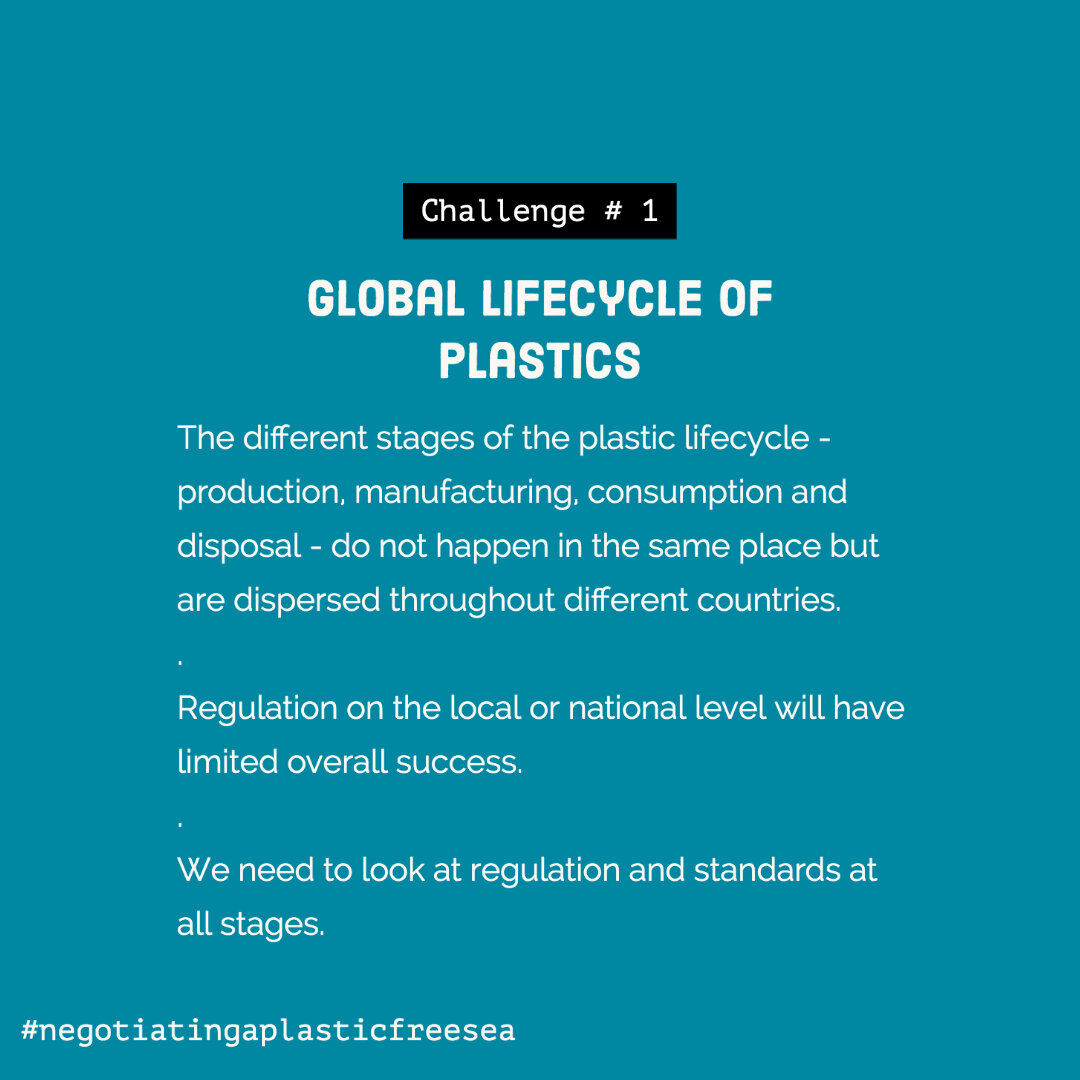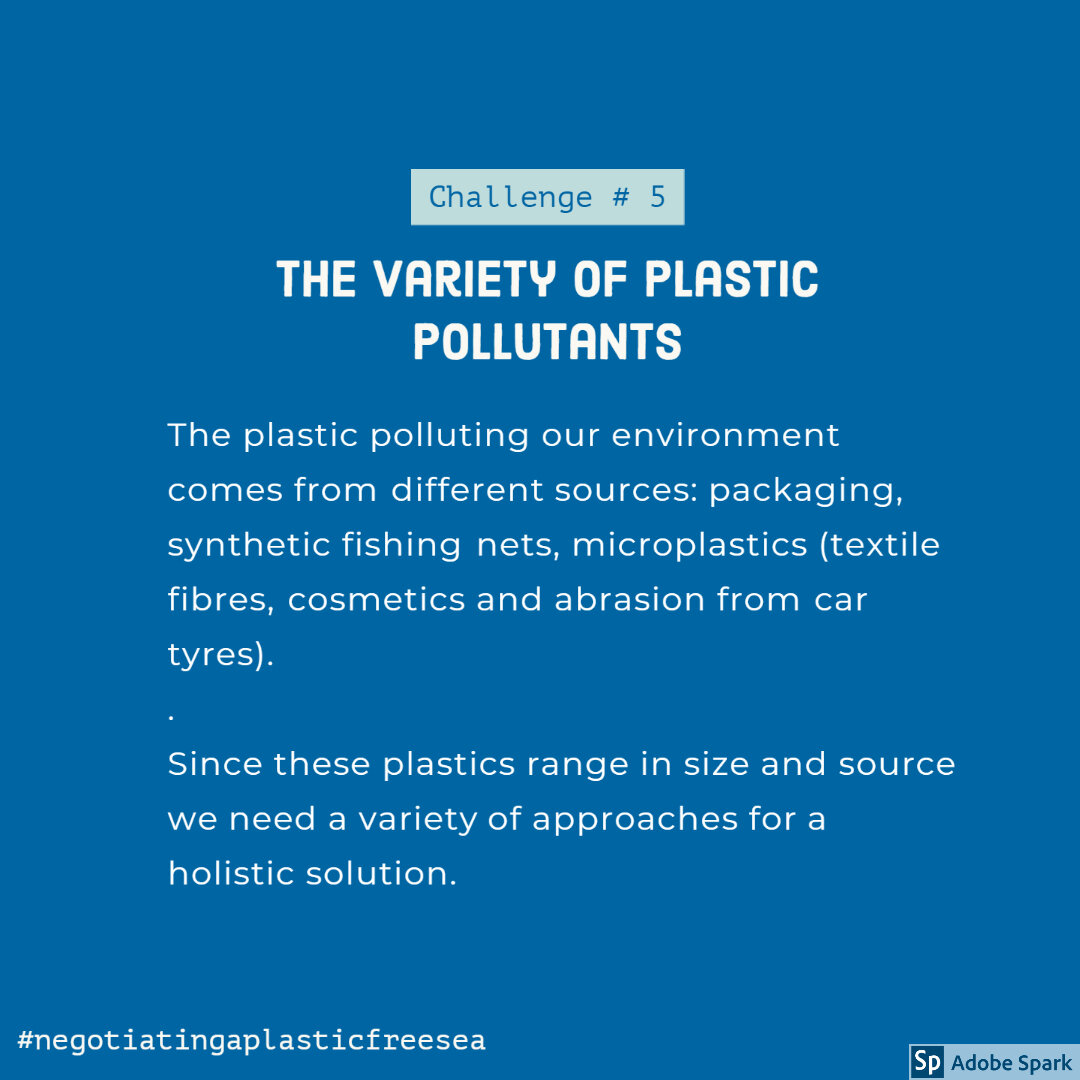Negotiating a Plastic Free Sea
Ina Tessnow-von Wysocki
Marine plastic pollution is a problem that our eyes see and our emotions connect to – it’s fair to say that plastic does not belong in the ocean and we should actively prevent it. Why then, is it so difficult to do so? What if governments came together in a joint effort to negotiate an agreement to tackle this problem - how do you make such a treaty successful? Ina Tessnow-von Wysocki guides us through her studies on what an international treaty would need to look like to solve the problem of plastic pollution.
What is the problem?
I have no doubt that you are aware of marine plastic pollution. You see pictures of plastic waste in the news. Those of you living near the ocean or rivers may find yourselves picking up plastic items on the beach and near the shoreline, catching plastic bags out of the air before the waves and the wind carry them into the depths of our oceans. You might avoid plastic bottles, straws or other disposables when you are grocery shopping or at restaurants. I do the same. But in the back of your mind there will always be the realisation that this will not stop the large amounts of plastic waste reaching our oceans (4.8- 12.7 million tonnes in a year!).
What can solve the problem on a global scale is joint political action by various actors from the different countries of our world. Here, I’ll show you what I have been working on and how I am convinced that politics and protecting our oceans is directly linked.
Plastic production and resulting waste is currently higher than it has ever been before. Photo: Pixbay.
Why has it not been solved already?
While some pollution originates from ships and other infrastructures at sea, a great majority of plastic waste enters the oceans from land - intentionally and unintentionally. Therefore, some projects have focused on “cleaning up” the oceans (e.g. The Ocean Cleanup), which is valuable to get rid of the plastic that is already in the oceans. However, is extremely difficult.
While it is important to think about how we can get rid of the plastic we have already discharged into the oceans, it is necessary to think about avoiding more plastic entering the oceans. “Turning off the tap” of plastic pollution, rather than merely trying to “scoop out” the bathtub.
Whilst it seems obvious that actions are needed to prevent further pollution, the problem remains. As you are reading this article, there are various people from NGOs, in governments, and in the United Nations working on this issue. There are many initiatives by people like you and me, commitments by businesses, and voluntary and binding agreements on national, regional, and international levels. So why then has the problem not been solved already?
The problem has one very significant characteristic: it is global. Thus, its solution will also need to be global. The following five challenges still exist that means that the current fragmented government efforts fail in solving the problem.





So, how do we solve it?
These five challenges show that the problem is of global nature and can only be tackled with a holistic global solution. One person, local community, national government, or regional organisation alone cannot solve this problem. Coordination amongst these actors is crucial because changes need to be made along the whole lifecycle of plastics. Various academics and NGOs have proposed to negotiate solutions on a global level, in the United Nations, and set binding regulations that would change the way our world is currently handling plastics. But what should such an instrument look like? Which elements would it need to include?
1. Make the Treaty Fair
It is extremely important for the success of the treaty that state representatives are included in the negotiation process and can influence the structure of the agreement. Moreover, the content of the agreement needs to be regarded as fair by the participating states. This is particularly important regarding who is responsible for what, including recycling, financial costs for infrastructure improvements, and transfer of technology – just to name a few.
The lifecycle of plastics affects countries around the world, including developed and developing countries. Plastic producing and/or consuming countries cannot point the entire responsibility to countries where plastic waste is proven to enter rivers and oceans, as we know that much plastic waste in developing countries results from plastic exports from elsewhere.
States won’t participate in something they don’t consider as fair - if they do sign up to an international agreement they don’t believe in, chances are they won’t hold up to the commitments, since there is no such thing as a world government to ensure everyone is abiding by the new rules. So, responsibility should be shared amongst all states, depending on their capabilities (the "Principle of common but differentiated responsibilities").
Responsibility of the issue needs to be shared amongst all countries involved in the life cycle of plastics. Photo: Pixabay.
2. Tackle Pollution from Land, from the Sea and consider the Whole Plastic Lifecycle
In order to eliminate marine plastic pollution, the treaty needs to tackle the sources of plastic pollution, including pollution from land and sea, and – particularly – consider the whole lifecycle of plastics. The plastic lifecycle is global and involves production, manufacture, consumption and disposal in different countries. The agreement would need to aim for a holistic approach, including guaranteeing transparency on the chemical components used for the production of plastics and and consider the variety of plastics in source, type, and size.
3. Link the Issue to Trade
Economic incentives have worked in previous international environmental agreements (e.g. the Montreal Protocol). If all the parties see an economic advantage in joining the agreement, this can increase participation and compliance.
In this case to eliminate plastic pollution, a link could be made to the international trade of plastics, at all stages of its lifecycle (plastic pellets, plastic products, plastic waste). This could enhance the willingness to be part of the group of states that agree to the regulations of the treaty.
For example, the treaty could set international standards for chemical components of plastics that are traded among the members of the agreement or set standards for recycling infrastructures prior to the import of plastic waste. States which would want to continue trade with plastics (at whatever stage) would in this way be required to make changes in how they currently operate.
4. Pool Money for the Necessary changes
In order to meet the challenge of a lack of recycling infrastructures and technologies and ensure the sustainable handling of waste, the agreement would need to establish some sort of financial mechanism to support the changes. Possible scenarios include the financial support by developed countries and the private sector.
5. Be Flexible
The agreement would need to be flexible and adaptable to be successful. Measures might change due to new scientific findings and the agreement would need to offer the necessary flexibility to stay effective. This flexibility could be built into the treaty text to avoid lengthy negotiations to amend the treaty after adoption by the parties.
6. Keep a Watchful Eye
Treaties set out certain regulations, which the participating states will need to commit to. It’s normally more likely that the states will hold up to their commitments when their actions are monitored and regularly reported on. So, the treaty needs to set out effective monitoring, reporting, and review procedures.
7. States Need to Step it Up
International law has no world-enforcer, and so states become the entities enforcing the law that they have made. Compliance can be incentivised, such as the issue-linkage (point 3), and non-compliance deterred through certain mechanisms. When considering an enforcement mechanism, it should be kept in mind that states will be more likely to comply to targets that they regard as fair, for which implementation is feasible, and when there is an economic advantage in being part of the agreement. Enforcement therefore should be by incentivising compliance and deterring non-compliance through cooperative means.
Next Steps Towards the Plastics Treaty
The idea for an international agreement to prevent further plastic pollution is already being discussed within groups focusing on the policy of plastic pollution. The topic of marine plastic pollution is increasingly on governments’ agendas. The United Nations convened an “Ad hoc Open-Ended Working Group on Marine Litter and Microplastics” to address the problem of plastic pollution on a global level, which met again in November 2019 and further discussed the potential for a global instrument to confront plastic pollution in our oceans.
If you are interested in a brief overview of current efforts to tackle marine plastic pollution and would like to make a difference but don’t know how: have a look at the webinar.
Beyond Plastics…
Besides plastic pollution, there are a myriad of issues threatening marine species and damaging ocean ecosystems. While some areas of the ocean are under the control of states, the majority of the ocean is not and belongs to everyone and no one at the same time. This requires cooperation on a global level when deciding on particular regulations in these areas. Additionally, with new technologies and scientific discoveries, the previously agreed regulations are no longer sufficient for dealing with the challenges and opportunities of our oceans.
For this reason, the United Nations are currently negotiating a new agreement to protect marine life, while at the same time leaving options open to sustainably use the ocean’s resources in international waters for human interests. This new instrument on the conservation and sustainable use of marine biological diversity of areas beyond national jurisdiction (BBNJ), aims to regulate human activities concerning marine biodiversity in the high seas.
What will this agreement include? Who will make decisions over our ocean? And on what grounds are arguments made for and against the use or conservation of the oceans and marine life?
Politics and protecting our oceans is directly linked. Photo: Pixabay.
Ina Tessnow-von Wysocki stays passionate about ocean protection and is currently doing her PhD at the University of Vienna as part of the research project MARIPOLDATA, where she is studying the science-policy interface of this currently negotiated treaty. If you’ve enjoyed this article from Ina, you can read the full paper here, or follow add her on LinkedIn.



